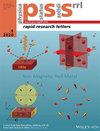Electronic Structure Evolution in the Temperature Range of Metal Insulator Transitions on Sn/Ge(111)
IF 2
4区 物理与天体物理
Q3 MATERIALS SCIENCE, MULTIDISCIPLINARY
引用次数: 0
Abstract
One third of monolayer of Sn adatoms on a Ge (111) substrate forms a two-dimensional triangular lattice with one unpaired electron per site. The system presents a metal-insulator transition when decreasing the temperature and it is known to exhibit strong electron-phonon coupling at 120-150 K. Here, we report a study of the electronic band structure for α-Sn/Ge(111) between 150 K and 5 K. We present both the experimental Fermi surfaces and the energy dispersions along high symmetry directions as a function of the temperature. At 5 K it is observed a weakly or low- dispersing spectral feature exhibiting an extended gap in the reciprocal space. This feature is derived from the topmost occupied band, which is metallic at high temperature and which develops a kink associated to strong electron-phonon coupling. The spectral evolution is partially explained with an increase of the electron-phonon coupling when decreasing the temperature. The increase of the electron-phonon coupling at low temperatures gives light into the new physics of this 2D system. The bandwidth is progressively reduced when reducing the temperature, enhancing the electronic correlation effects and triggering the Mott transition.锡/锗(111)上金属绝缘体转变温度范围内的电子结构演变
Ge(111)基底上三分之一的单层锡金刚石形成了二维三角形晶格,每个位点有一个未成对电子。在此,我们报告了 150 K 至 5 K 之间 α-Sn/Ge(111) 的电子能带结构研究。我们展示了实验费米面和沿高对称方向的能量散布与温度的函数关系。在 5 K 时,我们观察到一个弱分散或低分散的光谱特征,在倒易空间中表现出一个扩展的间隙。这一特征来自最顶端的占据带,该带在高温下具有金属特性,并在强电子-声子耦合作用下产生扭结。光谱演变的部分原因是温度降低时电子-声子耦合的增加。低温下电子-声子耦合的增加为这一二维系统的新物理学提供了启示。当温度降低时,带宽逐渐减小,从而增强了电子相关效应并引发了莫特转变。
本文章由计算机程序翻译,如有差异,请以英文原文为准。
求助全文
约1分钟内获得全文
求助全文
来源期刊

Physica Status Solidi-Rapid Research Letters
物理-材料科学:综合
CiteScore
5.20
自引率
3.60%
发文量
208
审稿时长
1.4 months
期刊介绍:
Physica status solidi (RRL) - Rapid Research Letters was designed to offer extremely fast publication times and is currently one of the fastest double peer-reviewed publication media in solid state and materials physics. Average times are 11 days from submission to first editorial decision, and 12 days from acceptance to online publication. It communicates important findings with a high degree of novelty and need for express publication, as well as other results of immediate interest to the solid-state physics and materials science community. Published Letters require approval by at least two independent reviewers.
The journal covers topics such as preparation, structure and simulation of advanced materials, theoretical and experimental investigations of the atomistic and electronic structure, optical, magnetic, superconducting, ferroelectric and other properties of solids, nanostructures and low-dimensional systems as well as device applications. Rapid Research Letters particularly invites papers from interdisciplinary and emerging new areas of research.
 求助内容:
求助内容: 应助结果提醒方式:
应助结果提醒方式:


